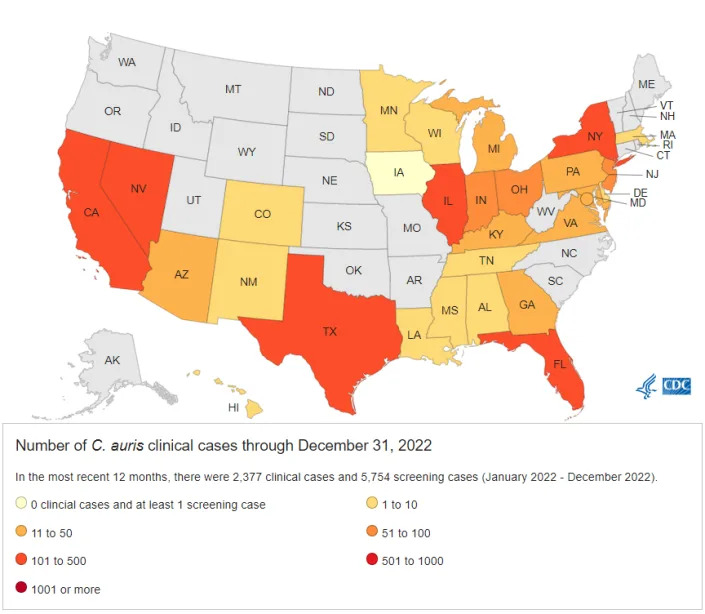https://www.yahoo.com/news/deadly-fungal-infection-spreading-alarming-000734788.html
READ EVERY WORD)
Deadly fungal infection spreading at an alarming rate, CDC says
The fungus can be found on the skin and throughout the body, according to the CDC. It's not a threat to healthy people, but about one-third of people who become sick with C. auris die.
In the CDC report, researchers analyzed state and local health department data on people sickened by the fungus from 2016 through Dec. 31, 2021, as well as those who were “colonized,” meaning they were not ill but were carrying it on their bodies with the potential of transmitting it to others who might be more vulnerable to it.
The number of infections increased by 59%, to 756, from 2019 to 2020 and then by an additional 95%, to 1,471, in 2021.
The researchers also found that the incidence of people not infected with the fungus but colonized by it increased by 21% in 2020, compared to 2019, and by 209% in 2021, with an increase to 4,041 in 2021 compared to 1,310 in 2020.
C. auris has now been detected in more than half of U.S. states, the new study found.

Most concerning was the increasing numbers of fungus samples resistant to the common treatments for it. Lyman hopes the paper will put C. auris on health care providers’ radar and spur facilities to practice “good infection control.”
The new findings are “worrisome,” said Dr. Waleed Javaid, an epidemiologist and an infectious disease expert and director of infection prevention and control at Mount Sinai Downtown in New York.
“But we don’t want people who watched 'The Last of Us' to think we’re all going to die,” Javaid said. “This is an infection that occurs in extremely ill individuals who are usually sick with a lot of other issues.”
Even if C. auris moves beyond health care facilities and into communities, it’s unlikely to become a problem for healthy people who do not have invasive medical devices, such as catheters, inserted into their blood vessels, Javaid said.
The main problem is preventing the fungus from spreading to patients in hospital intensive care units, Javaid said. Unfortunately C. auris can colonize not only people who come in contact with the fungus, but also patient rooms.
“By its nature it has an extreme ability to survive on surfaces,” he said. “It can colonize walls, cables, bedding, chairs. We clean everything with bleach and UV light.”
While the fungus was first identified in 2009 in Asia, scientists have determined that C. auris first appeared around the world about a decade earlier, after they re-examined older data and discovered instances where C. auris had been mistakenly identified as a different fungus, Dr. Graham Snyder, medical director of infection prevention at University of Pittsburgh Medical Center, said in an interview.
“It’s the pattern we’ve observed with these types of pathogens,” he said. “Often they start out extremely rare, then they emerge in more and more places and become widespread.”
It's important to stop the pathogen so it doesn’t spread beyond hospitals and long-term facilities like the drug-resistant bacteria MRSA did, Snyder said.
“It’s not unusual to see MRSA in the community now,” Snyder said. “Will that happen with C. auris? I don’t know. That’s partly why the CDC is raising the alarm.”
This article was originally published on NBCNews.com
......
No comments:
Post a Comment
Feel free to comment, even if you disagree with me ( smile )